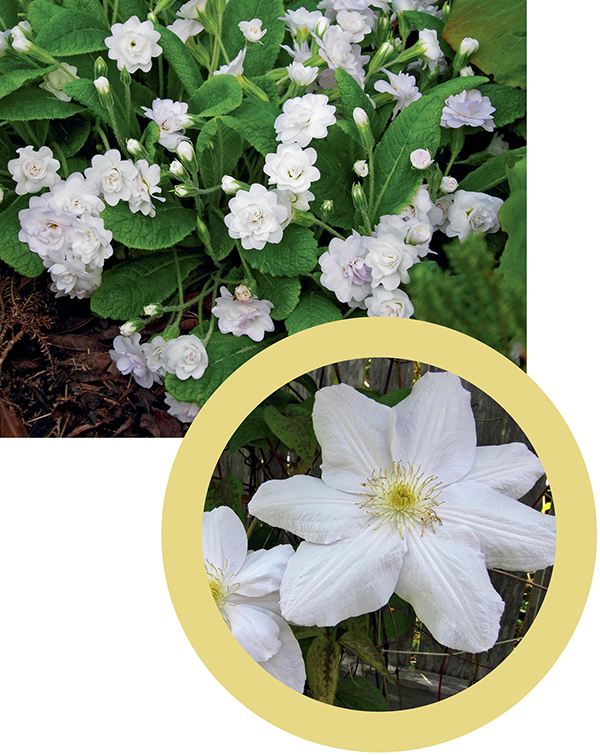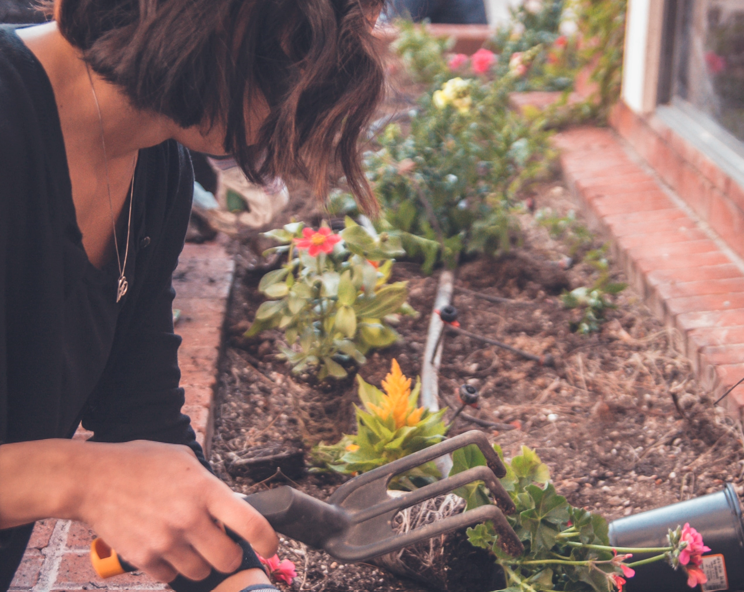Don’t underestimate the power of plain vanilla
Text and photos by Carol Hall
Flowering tobacco.
Choosing a flower colour is a bit like choosing an ice cream flavour from among several dozen tantalizing options: since the newest or most exotic tend to be the most tempting, other excellent choices are far too often ignored. With flavours, it’s vanilla. With flower colours, it’s white.
Why choose plain-vanilla white flowers? The reasons are many. White flowers tend to be bigger or more fragrant (or both) than brightly coloured ones. Many are especially fragrant after sundown, making them perfect choices for summer evenings on patios and balconies. They’re also luminous at night, and by moonlight they’re otherworldly beautiful.
In the daytime, white flowers have a purity, freshness, and elegance unmatched by any other colour. Large single white flowers are especially effective, but double white flowers can also be show-stopping. And every container gardener knows the value of bedding plants with multitudes of tiny white flowers, such as sweet alyssum, bacopa, and million bells (calibrachoa).
Why White?
We gardeners sometimes forget that flowers have their own reasons for looking as they do, the primary reason being to attract insects to pollinate them. Far back in evolutionary history, with zillions of flowers all competing for pollinators, different species evolved with specific shapes, sizes, colours, and perfumes to attract specific insects.
White flowers are the product of several unique solutions in the competition for pollinators. Instead of becoming ever more colourful, some became much more fragrant so that pollinators would be attracted to them even in shade. Others became larger and therefore easier targets than their colourful counterparts. Still others evolved to attract pollinating moths, which fly only at night: their luminosity (white blossoms all but glow in the dark) helps guide night-flying pollinators to them.
White for Fragrance
A high percentage of white flowers are exceptionally fragrant. Think mock orange (Philadelphus species, hardy to -40°C/F), Casa Blanca Oriental lily (Lilium ‘Casa Blanca’, to -29°C/-20°F), and viburnums such as Burkwood viburnum (Viburnum x burkwoodii), Korean Spice viburnum (V. carlesii), and fragrant snowball bush (V. x carlcephalum), all of which are hardy to -35°C/-30°F.
White flowers occurring as natural mutations of colourful flowers also tend to be more fragrant than the norm. For instance, common lilacs (Syringa vulgaris, to -40°) are renowned for their perfume, but double-flowered white cultivars such as ‘Madame Lemoine’ and the pink-budded ‘Krasavitsa Moskvy’ (Beauty of Moscow) have outstanding fragrance. Similarly, although most Narcissus triandrus cultivars (to -35°C) are sweetly fragrant, that of pure-white ‘Thalia’ is especially wonderful, keeping it popular for over 100 years.

‘Dawn Ansell’ double primrose and Clematis ‘Madame le Coultre’.
Moonlight Gardens
All white flowers literally shine in moonlight gardens, but fragrant ones—especially those most fragrant in the evening—are must-haves. Among several annuals called “flowering tobacco,” many gardeners swear that the most fragrant is Nicotiana sylvestris, a tall species with tubular white flowers that emit their most powerful perfume after dusk.
Although frost-tender, the highly scented flowers of the white angel’s trumpet (Brugmansia x candida cultivars) and the giant white moonflower vine (Ipomoea alba) can be enjoyed in containers anywhere. Both of these have large flowers of pure white that are most fragrant after sundown. Other tender vines whose powerfully fragrant white flowers deserve a place in summer moonlight gardens include night-blooming jasmine (Cestrum nocturnum) and star jasmine (Trachelospermum jasminoides), which blooms in daytime as well and is hardy on the West Coast.
White for Sun
Large or small, individual or massed, white flowers are indispensable in sun. Among roses, the hybrid tea cultivar ‘John F. Kennedy’ (to -35°C) is exceptionally fragrant and its large buds have the much-desired classic rose shape. Taking a different tack, the unscented landscape rose Alba Meidiland (Rosa ‘Meiflopan’, to -35°C) grows into a huge mound completely smothered with tiny double flowers. And ‘Iceberg’, a tidy, exceptionally reliable floribunda rose, is justly famous for its multitudes of small, lightly fragrant double flowers.
Excellent white-flowered clematis vines abound. They include Clematis ‘Madame le Coultre’ (to -35°C), whose huge flowers brighten even the smallest of gardens in May and June, and again in September, and sweet autumn clematis (C. terniflora, to -29°C), whose tiny but numerous sweetly scented flowers cover whole fences in fall.
For sheer impact, a semi-double white-flowered tree peony (Paeonia suffruticosa, to -35°C) is unforgettable, and a white Japanese wisteria (Wisteria floribunda ‘Alba’, to -29°C) draped over an arbour offers the ultimate romantic look. White-flowered magnolias are in a class by themselves, whether they’re star magnolias such as Magnolia stellata ‘Royal Star’ or saucer magnolias such as M. x soulangeana ‘Lennei Alba’ (both hardy to -35°C).
White Japanese wisteria.

‘John F. Kennedy’ hybrid tea rose; White tree peony; Snowdrift astilbe.
White for Shade
White flowers excel at brightening shady sites. Gardeners can choose from small trees such as flowering dogwoods (Cornus species, some to -35°C), shrubs such as Hydrangea arborescens ‘Annabelle’ (to -40°), ground covers such as white periwinkle (Vinca minor ‘Alba’, to -40°), summer annuals such as fuchsias, tuberous begonias, and impatiens, and any number of perennials.
Among perennials, white-flower astilbes (Astilbe species, to -40°), white bleeding hearts (Dicentra spectabilis ‘Alba’, to -45°C/ -50°F), white foxgloves (Digitalis purpurea f. albiflora, to -35°C), and white columbines (Aquilegia cultivars, to -45°C) are made for shade gardening. So are white primroses (Primula vulgaris, to -35°C), especially the exquisite double-flowered ‘Dawn Ansell’.
Mixers and Fixers
However pleasing the colour combinations you can bring to hanging baskets, planters, and beds, they’re made even better by including white. The same goes for permanent plantings: white accents make a big difference, whether added in spring (crocus, tulips, daffodils, hyacinths, lily-of-the-valley), summer (cosmos, petunias, wax begonias, daisies, snapdragons), or early fall (dahlias, asters, chrysanthemums, flowering cabbage). White flowers have yet another incredible power: whenever a colour clash occurs, no matter how hideous or hopeless it looks, just add white. Miraculously, the clash disappears—or at least ceases to be bothersome.
So much for white flowers being “plain vanilla.” But then again, perhaps vanilla isn’t quite as plain as you might think: even with the scores of exotic flavours available, the all-time worldwide favourite flavour of ice cream remains—you guessed it—plain vanilla.





